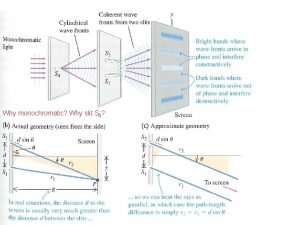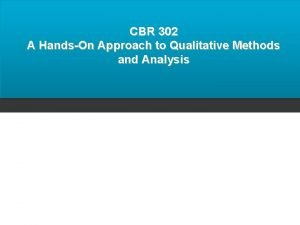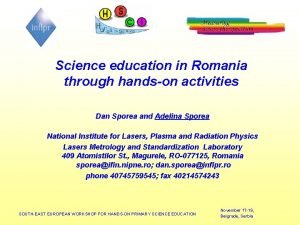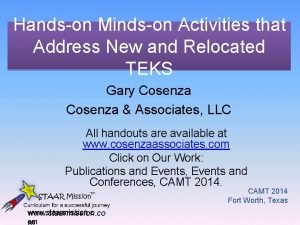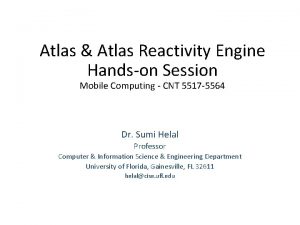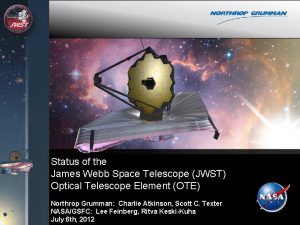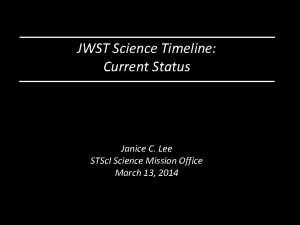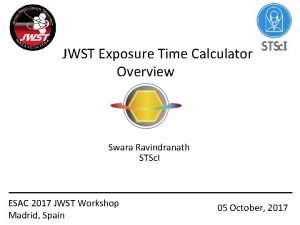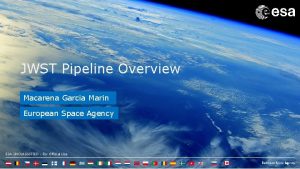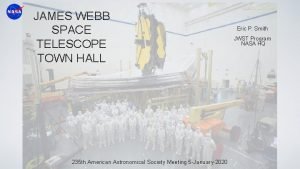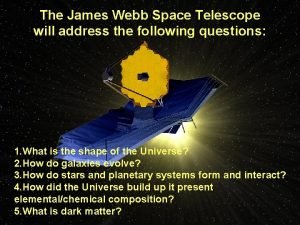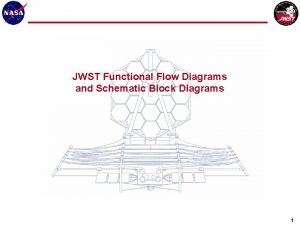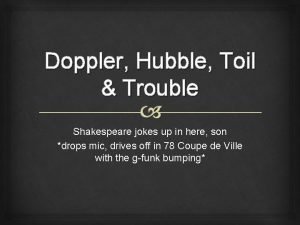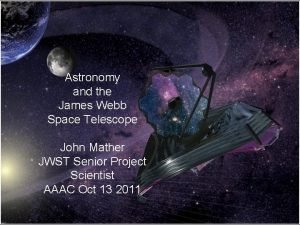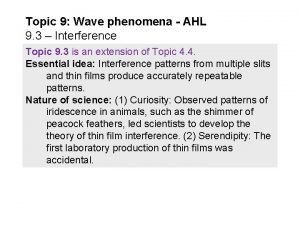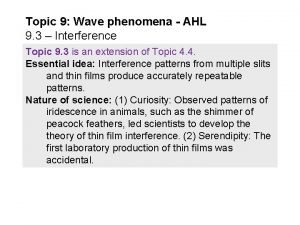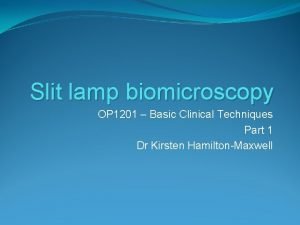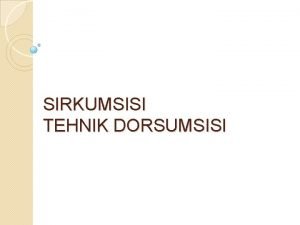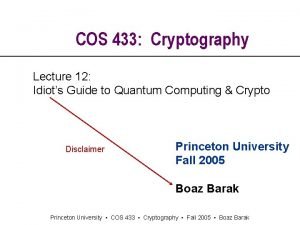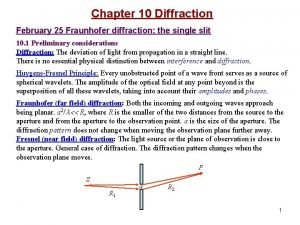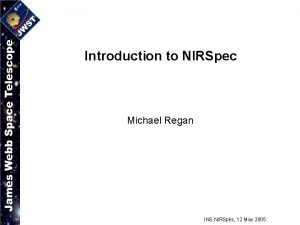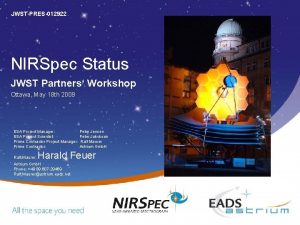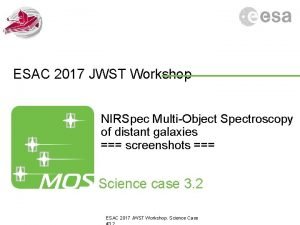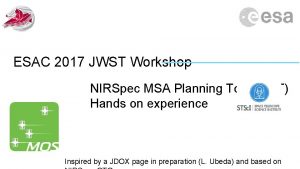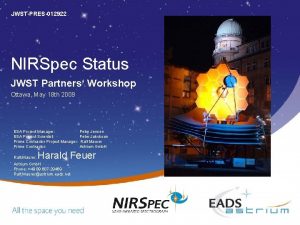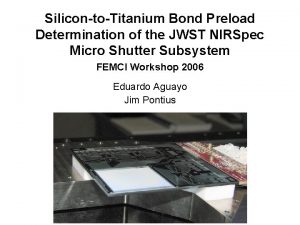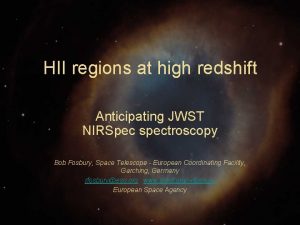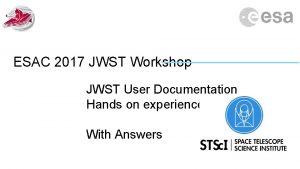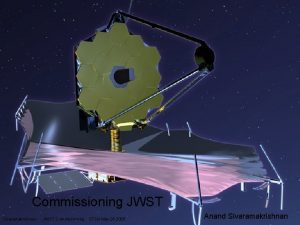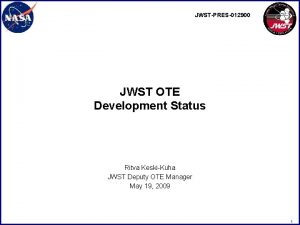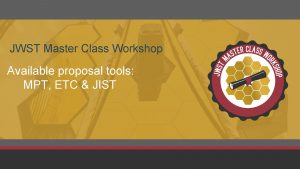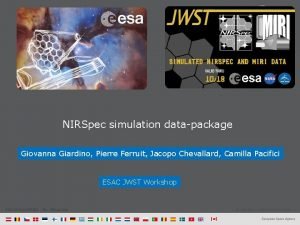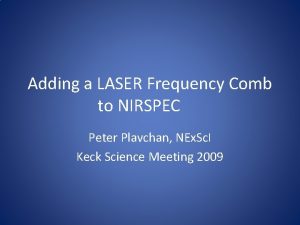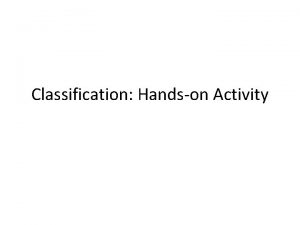JWST Master Class Workshop Slit handson NIRSpec and



























- Slides: 27

JWST Master Class Workshop Slit hands-on

NIRSpec and MIRI LRS Slit hands-on • Infrared spectroscopy of Y dwarfs ‣ NIRSpec ‣ MIRI LRS • In this hands-on session you will be asked to use: ‣ The Exposure Time Calculator (ETC) for the NIRSpec fraction ‣ The Astronomer’s Proposal Tool (APT) for both instruments • The MIRI LRS science case was already part of the ETC hands-on, so that part of the observation planning is assumed to be covered. Your Workshop Here 2

Thinking about strategies

NIRSpec Subarrays and Readout patterns • Subarray: ‣ ‣ • • • FULL Tailored subarrays per individual slit: SUBS 200 A 1, SUBS 200 A 2, SUBS 200 B 1, SUBS 400 A 1 S 1600 subarrays: SUB 2048, SUB 1024 A, SUB 1024 B, SUB 512 ALLSLITS (S 200 A 1 and S 200 A 2 combined to bridge the detectors gap, but not only. It can also be used to estimate background) Only traditional readout mode, not the IRS 2 noise reduction mode Readout patterns: NRS and NRSRAPID Note: maximum exposure duration is 10, 000 seconds Your Workshop Here

NIRSpec FS detector recommendations • Decision flow to specify detector parameters for a FS observation: • Saturation • Lower limit • Data volume Your Workshop Here

MIRI LRS Subarrays and Readout patterns • Subarray: ‣ ‣ • FULL (slit) SLITLESSPRISM (slitless for Time Series Observations - TSO) Readout patterns: ‣ ‣ SLOW ( t 1=23. 890 s) FAST ( t 1=2. 775 s). - In slitless mode, only FAST mode is allowed. where t 1 is the resulting group time. • The maximum exposure duration for a single exposure with the LRS slit is 10, 000 s. Your Workshop Here LRS slit and slitless spectra positions on MIRI imager focal plane

Background removal strategies • • • Pixel-to-pixel subtraction ‣ Compact sources: using nodding ‣ Extended sources: associated dedicated ″blank sky″ observation at off-scene position - for NIRSpec: performed only if grating wheel has not moved between the target and off-scene exposures Master background subtraction ‣ Standard for extended sources ‣ created from: - associated exposure, creating an independently flux-calibrated 1 D background spectrum - list of background elements (like off-source pixels) ‣ for NIRSpec: is set by pipeline processing if the grating wheel has moved In ETC, FS nod/dithers are accounted for at detector level, setting the number of exposures. APT: Dedicated observations for background must be linked to science observations in order to create an association list. This is defined at Target Level in APT. Necessary for pipeline processing flow. APT: If the background signal is time variable throughout the year, dedicated “blank-sky” observations should be scheduled consecutively to ensure pixel-to-pixel subtraction. Special requirements: Noninterruptible Your Workshop Here

NIRSpec Nods and dithers • Nods: offsets that produce data to be subtracted in pipeline processing, in order to cancel in-field background flux. Nod options are typically best used for targets that are not significantly spatially extended. (2, 3, or 5 points), depending on the number of exposures needed/possible. • Dithers: offsets of the target position over multiple exposures, to even out or mitigate detector effects, help remove cosmic rays, improve spatial sampling, and increase signal-to-noise and flux accuracy. • APT • Primary dithers: nod along the slit used to subtract background flux. Recommended 3, 5. • Sub-pixel dithers: to improve spatial and/or spectral pixel sampling, only in addition to Primary Dither pattern for point sources. Not recommended in spectral dimension. • Across gap SAM. Offset executed by selecting the option “S 200 A 1 and S 200 A 2” only in the high resolution gratings Your Workshop Here

NIRSpec Nods and dithers • Decision tree for choosing the right nod/dither pattern for FS observations based on the source compactess. Your Workshop Here

MIRI LRS Nods and dithers • For MIRI, dithering is required to achieve accurate photometry and to provide superior sampling (Gordon et al. 2015) • LRS slit dithers (for slitless mode, dithering is not allowed): ‣ ALONG SLIT NOD (default for compact sources) uses a 2 -point "nod" where a point source is dithered between positions that are located approximately 30% and 70% of the way along the slit length. ‣ MAPPING customizable offsets along-slit and across-slit. It is recommend that the chosen step sizes are smaller than, or on the order of the slit size (approx. 4. 7 x 0. 5"). Extended sources mapping can also be produced by mosaicing. Recommended dither steps of 1” in both directions. A dedicated background observation may be needed. ‣ NONE (only permitted for SLITLESSPRISM) Your Workshop Here Dithers ALONG SLIT NOD Layout on the LRS slit

NIRSpec FS Target Acquisition • FS TA methods: ‣ WATA (recommended) using science or offset target centred in S 1600 A 1. 11 -18 minutes. Expected accuracy: 20 mas, and depends on centroiding accuracy of the target (ephemeris). ‣ MSATA requires defining 5 -8 reference stars (may require pre-imaging). It is specified at the visit level of the observation, not directly at the observation template. 24 -30 minutes. Expected accuracy: 20 – 25 mas (optimal), <50 mas (relaxed), depending on the catalogue relative accuracy. ‣ NONE is not recommended for FS. The resulting pointing accuracy will be that delivered by the GS acquisition at the start of the observation. For reference, the absolute pointing performance of JWST for NIRSpec is expected to be 100 mas • Strategies and parameters: ‣ WATA: ‣ MSATA: ‣ ‣ Subarray configurations: SUB 32, SUB 2038, FULL (increasing frame time) Subarray configuration: FULL Filters: F 110 W, F 140 X, CLEAR Readout pattern: NRSRAPID, NRSRAPIDD 1, NRSRAPIDD 2, NRSRAPIDD 6 Groups/Integrations are fixed TA readout mode switch with respect to science parameters costs extra in time. Your Workshop Here

MIRI LRS Target Acquisition • TA procedure: ‣ LRS slit mode • • Use of science or offset target at distance <60 arcseconds • Strategies and parameters TA is NOT mandatory in the LRS slit APT template; however, for observations of point or compact sources it is highly recommended. ‣ ‣ ‣ Filters: F 560 W, F 1000 W, F 1500 W, and FND ‣ Groups are selectable but fixed (4, 6, 8, 10), integrations is always 1 Subarray configuration: N/A, controlled by the subarray science parameter Readout patterns: FAST(default), FASTGRPAVG 8, FASTGRPAVG 16, FASTGRPAVG 32, FASTGRPAVG 64 The user should always refer to the ETC for signal-to-noise calculations. Your Workshop Here

Science case

Science Overview • Goal ‣ To obtain spectroscopic observations of a Y dwarf across the entire JWST NIRSpec and MIRI LRS wavelength ranges to understand whether these atmospheres are shaped by chemical disequilibrium driven by vertical transport or the formation of water clouds, and constrain the object’s gravity, hence mass. Your Workshop Here

Observations Methodology • • Methodology ‣ Compare high-quality low and medium resolution Infrared spectra from 0. 6 to 13 microns, to models of cool atmospheres at different temperatures, gravity, degrees of turbulence, chemical equilibrium or disequilibrium driven by vertical transport, and clouds. Planned observations ‣ NIRSpec fixed slit spectroscopy ‣ MIRI LRS slit spectroscopy Source Type ‣ Point source Observation strategy ‣ PRISM and G 395 M dispersers for NIRSpec to obtain R~100 and R~1000, respectively and MIRI LRS R~100 ‣ 3 -point nod NIRSpec / 2 -point nod MIRI ‣ TA on science source Your Workshop Here

Getting started ETC NIRSpec WB ID: 30896 MIRI LRS WB ID: 30989

Scenes and Sources • NIRSpec: ‣ • 1 source with user supplied model spectrum morley_spec_ETC_noscale. txt renormalized to measured Vega magnitudes HST/WFC 3 F 140 X. MIRI ‣ Workbook: 30989 Your Workshop Here

Calculations • Overview Your Workshop Here

NIRSpec Calculation for Target Acquisition • WATA in ETC is available. Your Workshop Here

Getting started APT

Cheat APT screenshots…

APT Fixed-slit spectroscopy templates • When creating a new observation, the user defines the APT template • APT fixed-slit spectroscopy templates are divided into four sections: ‣ ‣ Generic information Observation information Target acquisition parameters Science parameters Your Workshop Here

APT Fixed slit spectroscopy template • NIRSpec Generic information Observation information Your Workshop Here

APT Fixed slit spectroscopy template • NIRSpec Your Workshop Here

APT Fixed slit spectroscopy template • MIRI Your Workshop Here

Further reading

Slit Help and JDOX • Detector Strategies ‣ • • NIRSpec detector recommended strategies NODS and Dithers ‣ NIRSpec Background Recommended Strategies ‣ MIRI LRS Recommended Strategies – Background observations ‣ NIRSpec Dithering Recommended Strategies - FS ‣ MIRI LRS Dithering Recommended Strategies Target Acquisition ‣ ‣ ‣ NIRSpec Target Acquisition Recommended Strategies MIRI Target Acquisition Generic Recommended Strategies MIRI LRS Target Acquisition Recommended Strategies Your Workshop Here
 Double slit vs single slit
Double slit vs single slit This is the religion that god accepts
This is the religion that god accepts Handson may
Handson may Analytical research
Analytical research James handson
James handson James handson
James handson A handson
A handson Handson activities
Handson activities Handson activities
Handson activities Handson session
Handson session Jwst status
Jwst status Jwst current status
Jwst current status Jwst launch
Jwst launch Jwst etc
Jwst etc Macarena garcia marin
Macarena garcia marin Jwst town hall
Jwst town hall Jwst
Jwst Mcc-1a jwst
Mcc-1a jwst Jwst
Jwst Jwst
Jwst Single slit envelope
Single slit envelope Ahl film
Ahl film Slit lamp technique
Slit lamp technique Teknik sirkumsisi
Teknik sirkumsisi Single slit envelope
Single slit envelope Double slit experiment
Double slit experiment Single slit envelope
Single slit envelope Inguinal triangle
Inguinal triangle
